ROCKS AND MINERALS
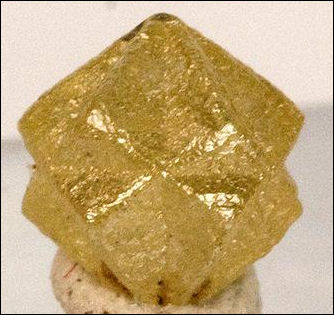
diamond Rocks are composed or minerals. A rock is an aggregate of one or more minerals; or a body of undifferentiated mineral matter. A mineral is a naturally occurring inorganic element or compound having an orderly internal structure and characteristic chemical composition, crystal form, and physical properties. Some rocks are crystals. A crystal is piece of a homogeneous solid substance having a naturally geometrically regular form with symmetrically arranged plane faces. [Sources: Mostly from USGS, CliffNotes (Weathering and Soil) and newspaper articles]
Geologist classify the Earth's rocks into three categories: 1) igneous, formed by magma within the Earth;. 2) sedimentary, formed when sand, clay or other materials are deposited by water, wind or glacial action and cemented together by pressure and chemical reactions; and 3) metamorphic, sedimentary or igneous rocks that have been later modified by heat and pressure or natural processes.
Diamonds, rubies and other gems are rocks. Most gems are crystals formed by the cooling of hot gases, solutions and melts deep inside the earth. When excited atoms lose energy from cooling they form a lattice, typical of crystals. The natural laws that create gems are the same as those that create snowflakes and salt, except that tremendous pressures and temperatures are needed. Diamonds can only form at depths of 100 miles or more below the earth's surface where pressures are a million pounds per square inch and temperatures are above 2,500̊F.╿
How do we get minerals? Minerals must be mined from the ground, either by surface, underground, or drilling methods. Sand and gravel is usually mined in surface pits or rock is crushed to size, gold is mined in surface pits, underground mines, and in streams and rivers.
Igneous Rocks
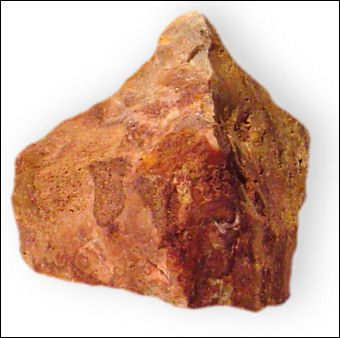
rhyolite, a kind of igneous rock Igneous rocks include granite (made of crystals of quartz and feldspar, mixed with other minerals). Igneous rocks form when molten rock (magma) originating from deep within the Earth solidifies. The chemical composition of the magma and its cooling rate determine the final igneous rock type.
Intrusive igneous rocks are formed from magma that cools and solidifies deep beneath the Earth’s surface. The insulating effect of the surrounding rock allows the magma to solidify very slowly. Slow cooling means the individual mineral grains have a long time to grow, so they grow to a relatively large size. Intrusive rocks have a characteristically coarse grain size.
Extrusive igneous rocks are formed from magma that cools and solidifies at or near the Earth’s surface. Exposure to the relatively cool temperature of the atmosphere or water makes the erupted magma solidify very quickly. Rapid cooling means the individual mineral grains have only a short time to grow, so their final size is very tiny, or fine-grained Sometimes the magma is quenched so rapidly that individual minerals have no time to grow. This is how volcanic glass
Sedimentary Rocks

Polished caymanite,
sedimentary rock Sedimentary rocks are formed from pre-existing rocks or pieces of once-living organisms. They form from deposits that accumulate on the Earth's surface. Sedimentary rocks often have distinctive layering or bedding.
Among the most common types of sedimentary rocks are sandstone (made from sand cemented together), limestone (made from the skeletons of lime-secreting plants and animals such as coral cemented together), shale (made from clay cemented together), and conglomerates (made from gravel cemented together). These rocks often start as sediments carried in rivers and deposited in lakes and oceans. When buried, the sediments lose water and become cemented to form rock. Tuffaceous sandstones contain volcanic ash.
Clastic sedimentary rocks are the group of rocks most people think of when they think of sedimentary rocks. Clastic sedimentary rocks are made up of pieces (clasts) of pre-existing rocks. Pieces of rock are loosened by weathering, then transported to some basin or depression where sediment is trapped. If the sediment is buried deeply, it becomes compacted and cemented, forming sedimentary rock. Clastic sedimentary rocks may have particles ranging in size from microscopic clay to huge boulders. Their names are based on their clast or grain size. The smallest grains are called clay, then silt, then sand. Grains larger that 2 millimeters are called pebbles. Shale is a rock made mostly of clay, siltstone is made up of silt-sized grains, sandstone is made of sand-sized clasts, and conglomerate is made of pebbles surrounded by a matrix of sand or mud.
Chemical sedimentary rocks are formed by chemical precipitation. This process begins when water traveling through rock dissolves some of the minerals, carrying them away from their source. Eventually these minerals are redeposited when the water evaporates away or when the water becomes over- saturated. Biologic sedimentary rocks form from once-living organisms. They may form from accumulated carbon-rich plant material or from deposits of animal shells.
Metamorphic Rocks
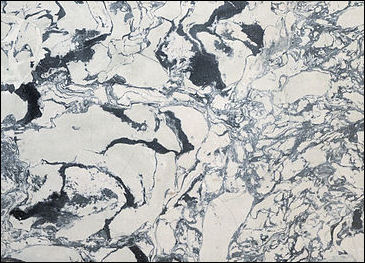
marble, metamorphic rock Metamorphic rocks started out as some other type of rock, but have been substantially changed from their original igneous, sedimentary, or earlier metamorphic form. Metamorphic rocks form when rocks are subjected to high heat, high pressure, hot, mineral-rich fluids or, more commonly, some combination of these factors. Conditions like these are found deep within the Earth or where tectonic plates meet.
The process of metamorphism does not melt the rocks, but instead transforms them into denser, more compact rocks. New minerals are created either by rearrangement of mineral components or by reactions with fluids that enter the rocks. Pressure or temperature can even change previously metamorphosed rocks into new types. Metamorphic rocks are often squished, smeared out, and folded. Despite these uncomfortable conditions, metamorphic rocks do not get hot enough to melt, or they would become igneous rocks!
Common metamorphic rocks include schist, marble, and gneiss. Gneiss is usually derived from sedimentary rock such as conglomerate or igneous rock like granite. Schists are made from partial recrystalization of shales under the action of heat and pressure.
Some kinds of metamorphic rocks — granite gneiss and biotite schist are two examples — are strongly banded or foliated. (Foliated means the parallel arrangement of certain mineral grains that gives the rock a striped appearance.) Foliation forms when pressure squeezes the flat or elongate minerals within a rock so they become aligned. These rocks develop a platy or sheet-like structure that reflects the direction that pressure was applied.
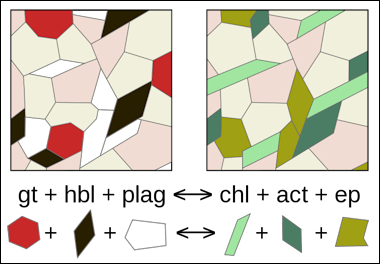
Metamorphic reactions Non-foliated metamorphic rocks do not have a platy or sheet-like structure. There are several ways that non-foliated rocks can be produced. Some rocks, such as limestone are made of minerals that are not flat or elongate. No matter how much pressure you apply, the grains will not align! Another type of metamorphism, contact metamorphism, occurs when hot igneous rock intrudes into some pre-existing rock. The pre-existing rock is essentially baked by the heat, changing the mineral structure of the rock without addition of pressure.
Weathering
The process of weathering alters rocks at the earth's surface and breaks them down over time into fine-grained particles of sediment and soil. Weathering is the result of the interactions of air, water, and temperature on exposed rock surfaces and prepares the rock for erosion. Erosion is the movement of the particles by ice, wind, or water. The particles are then transported by that agent until they are deposited to form sedimentary deposits, which can be later eroded again or transformed into sedimentary rocks. The weathering of the sediment grains continues during erosion and transportation. Weathering is generally a long, slow process that is continuously active at the earth's surface. [Source: CliffsNotes.com. Weathering, Cliff Notes Cliff Notes ]
There are two kinds of weathering: mechanical and chemical. Mechanical weathering is the process by which rocks are broken down into smaller pieces by external conditions, such as the freezing of water in cracks in the rock. The rock is chemically weathered when it reacts with rain, water, and the atmosphere to destroy chemical and mineralogical bonds and form new minerals. For example, feldspar crystals in a volcanic tuff commonly weather to form new clay minerals. Other minerals, such as calcite, dissolve. Quartz, on the other hand, is very resistant to weathering.
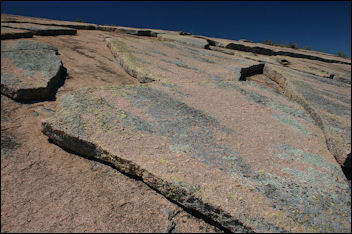
exfoliation of granite rock Chemical weathering weakens the bonds in rocks and makes them more vulnerable to decomposition and erosion. Thus, the weathered surface of a rock, whether it is an outcrop in the field or the stone walls of a building on a downtown street, looks different from the “fresh” interior of the rock. The most noticeable effect is the discoloration of the surface that results from the breakdown of minerals.
A spherically weathered boulder forms when the corners of an angular rock are broken down more quickly than the flat surfaces, forming rounded shapes. Differential weathering results when some rocks resist weathering more than other rocks, creating uneven rates of weathering and erosion. This phenomenon often forms arched natural bridges or spectacular mushroom-shaped rock formations, where a broad, more-resistant sandstone ledge is perched on a narrower column of less-resistant shale that has eroded more quickly.
Chemical weathering and mechanical weathering often work in concert to decompose rocks. Both processes occur in place. No movement is involved in weathering. Chemical weathering involves a chemical change in at least some of the minerals within a rock. Mechanical weathering involves physically breaking rocks into fragments without changing the chemical make-up of the minerals within it. It’s important to keep in mind that weathering is a surface or near-surface process. As you know, metamorphism also produces chemical changes in rocks, but metamorphic chemical changes occur at depth where either the temperature and/or pressure are significantly higher than conditions found on the Earth’s surface. [Source: USGS]
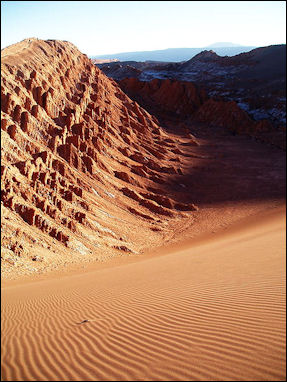
wind erosion As soon as a rock particle (loosened by one of the two weathering processes) moves, we call it erosion or mass wasting. Mass wasting is simply movement down slope due to gravity. Rock falls, slumps, and debris flows are all examples of mass wasting. We call it erosion if the rock particle is moved by some flowing agent such as air, water or ice.So, here it is: if a particle is loosened, chemically or mechanically, but stays put, call it weathering. Once the particle starts moving, call it erosion.
Processes of Mechanical Weathering
Ice. The formation of ice in the myriad of tiny cracks and joints in a rock's surface slowly pries it apart over thousands of years. Frost wedging results when the formation of ice widens and deepens the cracks, breaking off pieces and slabs. Frost wedging is most effective in those climates that have many cycles of freezing and thawing. Frost heaving is the process by which rocks are lifted vertically from soil by the formation of ice. Water freezes first under rock fragments and boulders in the soil; the repeated freezing and thawing of ice gradually pushes the rocks to the surface. [Source: CliffsNotes.com, Processes of Mechanical Weathering, Cliff Notes Cliff Notes ]
Exfoliation. If a large intrusion is brought to the surface through tectonic uplift and the erosion of overlying rocks, the confining pressure above the intrusion has been released, but the pressure underneath is still being exerted, forcing the rock to expand. This process is called unloading. Because the outer layers expand the most, cracks, or sheet joints, develop that parallel the curved outer surface of the rock. Sheet joints become surfaces along which curved pieces of rock break loose, exposing a new surface. This process is called exfoliation; large rounded landforms (usually intrusive rocks) that result from this process are called exfoliation domes. Examples of exfoliation domes are Stone Mountain, Georgia, and Half Dome in Yosemite National Park.
Friction and impact. Rocks are also broken up by friction and repeated impact with other rock fragments during transportation. For example, a rock fragment carried along in a river's current continuously bounces against other fragments and the river bottom and eventually is broken into smaller pieces. This process occurs also during transportation by wind and glacial ice.

Hoodoo formation Other processes. Less important agents of mechanical weathering include the burrowing of animals, plant roots that grow in surface cracks, and the digestion of certain minerals, such as metal sulfides, by bacteria. Daily temperature changes, especially in those regions where temperatures can vary by 30 degrees centigrade, result in the expansion and contraction of minerals, which weaken rocks. Extreme temperature changes, such as those produced by forest fires, can force rocks to shatter.
Processes of Chemical Weathering
When a rock is brought to the surface millions or billions of years after it has formed, the original minerals that were crystallized deep in the crust under high pressures and temperatures are unstable in the surface environment and eventually break down. The primary agents in chemical weathering are water, oxygen, and acids. These react with surface rocks to form new minerals that are stable in, or in equilibrium with, the physical and chemical conditions present at the earth's surface. Any excess ions left over from the chemical reactions are carried away in the acidic water. For example, feldspar minerals will weather to clay minerals, releasing silica, potassium, hydrogen, sodium, and calcium. These elements remain in solution and are commonly found in surface water and groundwater. Newly deposited sediments are often cemented by calcite or quartz that is precipitated between the sediment grains from calcium- and silicabearing water, respectively. [Source: CliffsNotes.com. Processes of Chemical Weathering, Cliff Notes Cliff Notes ]
How quickly chemical weathering breaks a rock down is directly proportional to the area of rock surface exposed. Thus, it is also related to mechanical weathering, which creates more exposed surface area by breaking the rock down into pieces, and those pieces into smaller pieces. The greater the number of pieces, the greater the total amount of surface area exposed to chemical weathering.
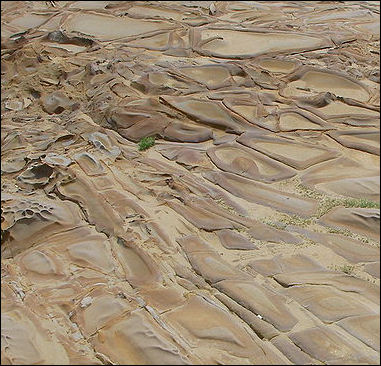
ring chemical weathering Water. Chemical weathering is most intense in areas that have abundant water. Different minerals weather at different rates that are climate dependent. Ferromagnesian minerals break down quickly, whereas quartz is very resistant to weathering. In tropical climates, where rocks are intensely weathered to form soils, quartz grains are typically the only component of the rock that remains unchanged. Alternatively, in dry desert climates, minerals normally susceptible to weathering in wet environments (such as calcite) can be much more resistant.
Acids. Acids are chemical compounds that decompose in water to release hydrogen atoms. Hydrogen atoms frequently substitute for other elements in mineral structures, breaking them down to form new minerals that contain the hydrogen atoms. The most abundant natural acid is carbonic acid, a weak acid that consists of dissolved carbon dioxide in water. Rainwater usually contains some dissolved carbon dioxide and is slightly acidic. The burning of coal, oil, and gasoline releases carbon dioxide, nitrogen, and sulfur into the atmosphere, which react with rainwater to form much stronger carbonic, nitric, and sulfuric acids that damage the environment ( acid rain).
Other acids that can affect the formation of minerals in the nearsurface weathering environment are organic acids derived from plant and humus material. Strong acids that are naturally occurring in the environment are rare — they include the sulfuric acids and hydrofluoric acids released during volcanic and hot spring activity.
Solution weathering is the process by which certain minerals are dissolved by acidic solutions. For example, calcite in limestone is dissolved easily by carbonic acid. Rain that percolates through cracks and fissures in limestone beds dissolves calcite, making wider cracks that can ultimately develop into cave systems.
Oxygen. Oxygen is present in air and water and is an important part of many chemical reactions. One of the more common and visible chemical weathering reactions is the combination of iron and oxygen to form iron oxide (rust). Oxygen reacts with iron-bearing minerals to form the mineral hematite (Fe2O3) , which weathers a rusty brown. If water is included in the reaction, the resultant mineral is called Iimonite (Fe2O3 nH2O) , which is yellow-brown. These minerals often stain rock surfaces a reddish-brown to yellowish color.
Soil and Dirt
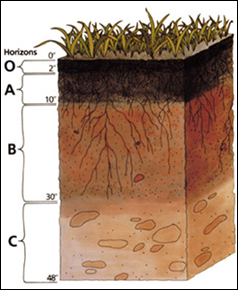
Soil profile The layers of weathered particles of earth material that contain organic matter and can support vegetation are defined as soil. Soil can be all or just part of the sedimentary material that covers the bedrock. For example, in Wisconsin the bedrock is covered by up to 120 meters (400 feet) of glacial gravel, sand, silt, and clay — yet only the upper few feet is considered to be soil. It can take hundreds of thousands of years to form soil. Soil contains mostly quartz and clay particles of varying sizes. The quartz sand grains help keep the soil porous, and the clay particles hold water and nutrients for plant growth. Loam contains sand, silt, and clay with abundant organic material. Topsoil is the upper part of a section of loam, has the highest organic content, and is considered to be the most fertile layer. The rocky subsoil underlies the topsoil and contains less organic material. [Source: CliffsNotes.com. Soil, Cliff Notes Cliff Notes ]
Residual soil and transported soil. When soil is developed from the weathering of the underlying bedrock it is called residual soil. Transported soil is deposited by agents such as ice and water and is not derived from the underlying bedrock. Examples include sand left by retreating glaciers and the mud that is left after a flood. Much of the rich black soil in the midwestern United States was deposited by melting glaciers about 10,000 years ago.
In a review of the book “DIRT The Ecstatic Skin of the Earth” (1996) by William Bryant Logan, David Walton wrote in the New York Times: Even someone who can't tell a flocculated benthic from a haploquod soil will find much of interest in William Bryant Logan's "Dirt," a word he prefers to the more refined "soil" or "earth." As he writes, human bodies belong to and depend on dirt. The ninth-century Persian physician Rhazes placed his infirmary on the spot where meat rotted the most rapidly; it is now believed that such sites were especially high in penicillium. (Today, Mr. Logan writes, many grave sites are toxic neighbors not because of the putrefaction of corpses but because of the leeching of formaldehyde.) Farmers used to taste dirt to judge its acidity; this country's industrial might rested on the richness of Midwestern soils, writes Mr. Logan, the environmental columnist at House Beautiful, just as the depletion of Mesopotamian and Roman fields marked the decline of those empires. "We spend our lives hurrying away from the real, as though it were deadly to us" he writes. "But the soil is all of the earth that is really ours." [Source: David Walton, New York Times, January 7, 1996]
Soil Horizons
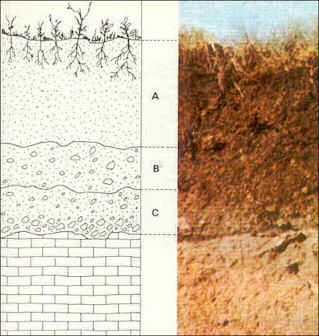
soil structure A fully developed soil, or mature soil, consists of three layers, or soil horizons. The uppermost layer is called the A horizon. Meteoric water moves down through the horizon and typically leaches clay minerals, iron, and calcite from the soil. The top part of the A horizon consists of the dark, organic loamy topsoil (the thin layer of humus and plant litter on the surface that is usually considered part of the A horizon is sometimes referred to as the O horizon); the rest of the horizon is a pale yellowish-tan.
The middle layer is called the B horizon or the zone of accumulation. The leached materials from the A horizon often precipitate in this more clay-rich zone that is reddish-brown from iron minerals. This horizon is also called the subsoil. The combined O-A-B section is sometimes called the solum. Known as the “true soil,” the solum is where most of the biological activity in soil is confined.
The C horizon is the lowest soil layer and lies directly above the bedrock. This layer is part soil and part decomposing bedrock fragments. It contains very little organic material. The interface between the bedrock surface and overlying sedimentary material is called the regolith and consists of broken, rubbly pieces of bedrock that are variably weathered and decomposed.
Immature soils do not have the complete O-A-B-C profile and are commonly found on steep slopes, where the weathering products migrate down the slope instead of accumulating in place.
Soil Types
The kind of soil that develops, and how quickly it develops, depends largely on the parent rock and the climate. Felsic rocks with high amounts of quartz weather to light-colored soil consisting of sand and clay with quartz grains. A basalt, on the other hand, which has a high percentage of ferromagnesian minerals, weathers to a darker-colored soil that is higher in clay content and lower in quartz.
Parent rocks form soils the most rapidly in wet, humid climates, where chemical weathering is enhanced. A pedalfer is a B horizon that is high in aluminum and iron. It develops in response to abundant rainfall, organic acids, and strong downward leaching. Pedocals are formed in arid climates by water drawn upward by subsurface evaporation and capillary action, which often crystallizes hard calcium salts in the soil. Pedocals are thin and poorly leached and have only a small amount of humus. Alkali soils, such as the white salt flats in the western United States, are pedocals that are toxic to plants because of the high salt content. Hardpan is a layer of soil, usually the B horizon, that is so hard (usually cemented by calcite or quartz) that it must sometimes be blasted loose. Common in the western United States, a hardpan formed by the precipitation of salt by evaporation is called caliche.
Laterites are highly leached, residual soils that form in tropical regions. The high temperature and rainfall result in deep and intense weathering. The laterite is typically bright red and composed of iron and aluminum oxides that are the most resistant to leaching. Valuable metals such as aluminum, copper, silver, gold, nickel, and iron are concentrated in laterites through secondary enrichment and can sometimes be mined economically. Secondary enrichment works in two ways: It can remove many of the other elements from the rock, which enriches the remaining valuable elements in place, or it can leach valuable elements such as copper and gold and deposit them at a particular level lower in the laterite.
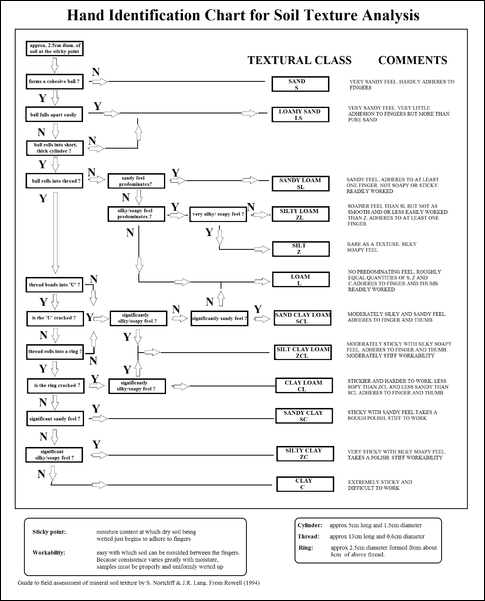
Soil texture chart
Image Sources: Wikimedia Commons, United States Geological Survey (USGS)
Text Sources: Mostly from USGS, CliffNotes (Weathering and Soil) and articles from the New York Times, Washington Post, Los Angeles Times, Times of London, Yomiuri Shimbun, The Guardian, National Geographic, The New Yorker, Time, Newsweek, Reuters, AP, Lonely Planet Guides, Compton’s Encyclopedia and various books and other publications.
Last updated April 2022
